The re-opening of the 9km Levenmouth branch in 2024 will be the fifth Scottish rail re-opening in the last 20 years. Previous re-openings were the Larkhall branch (5km) in 2005; Stirling to Alloa (21km) in 2008; Airdrie to Bathgate (22km) in 2010; and the Borders Railway (49km) in 2015.
These projects built a new railway on an abandoned track bed which had some bridges removed and obstructions built on the line. In contrast, the Levenmouth branch was never formally closed. Although its passenger services ceased in 1969, freight traffic to the Cameron Bridge distillery ran until 1998.
Since then, the line had no regular traffic and was not maintained as, although still owned by Network Rail, it was declared out of use under Short Term Network Change provisions. Hence, Parliamentary powers were not required to reopen the line.
For many years, the Levenmouth Rail Campaign pressed the case for the line’s re-opening to serve the largest community without a railway in Scotland. Its case was favourably received at a Scottish Parliamentary debate in September 2017 at which the Levenmouth Sustainable Transport study was announced. In May 2019, this concluded that a direct Leven to Edinburgh rail service would enhance the local economy with better access to employment and education. The Scottish Government announced the lines re-opening in August 2019.
Work starts
By June 2020, option selection work concluded that the line is to be double-tracked with two stations at Cameron Bridge and Leven, and built to W12 loading gauge for rail freight. As part of the Scottish Government’s Rail Services Decarbonisation Action Plan, the line will be electrified although it will not be energised until the Fife electrification scheme is complete a few years later. In January 2022, the Scottish Government announced that the railway will open in spring 2024 at a cost of £117 million.
Work to clear vegetation started in September 2020, followed by site investigation work early in 2021 and track removal from July 2021.
In March 2022, Thornton North Junction received heavy maintenance to provide a connection to the branch. This is a single lead junction which did not need to be remodelled. Though technically operational, this junction last saw regular use for coal traffic on the first kilometre of the line in 2015. March also saw the first mile of track from the junction being laid and the establishment of the first construction compounds.
At this time the five river bridges were being repaired. These were generally in good condition though they needed grit-blasting back to bare metal, recoated with a special paint system and new timber decks installed. This work required the bridges to be fully encapsulated.
Rail Engineer issue 197 (Jul-Aug 2022) provides more detail about the project and how it is being delivered. This article reports on progress since our site visit in May.
Stations
In December 2021, there was a community engagement exercise on possible sites for the new stations at Cameron Bridge and Leven. Due to the Covid situation, this had to be done online. Following this exercise, the locations of the stations were finalised. The selected Leven station site is the most southerly option and is next to the bus station and leisure centre. At Cameron Bridge the only possible option was the most easterly option, off the busy A915 road. This was determined by the Control of Major Accident Hazards (COMAH) regulations which require a minimum distance from the Diageo distillery which is a lower tier COMAH site.
Cameron Bridge station consists of two 196-metre platforms with a footbridge and lifts. Its car park will have 125 spaces, including 12 for electric cars. There is space for a further 300 spaces should these be required once the railway opens. This could be quite likely as the new station will be a railhead for the East Neuk of Fife. There will also be storage for 16 cycles. With 8,000 living within 2km of the station, active travel routes will be provided as described later.
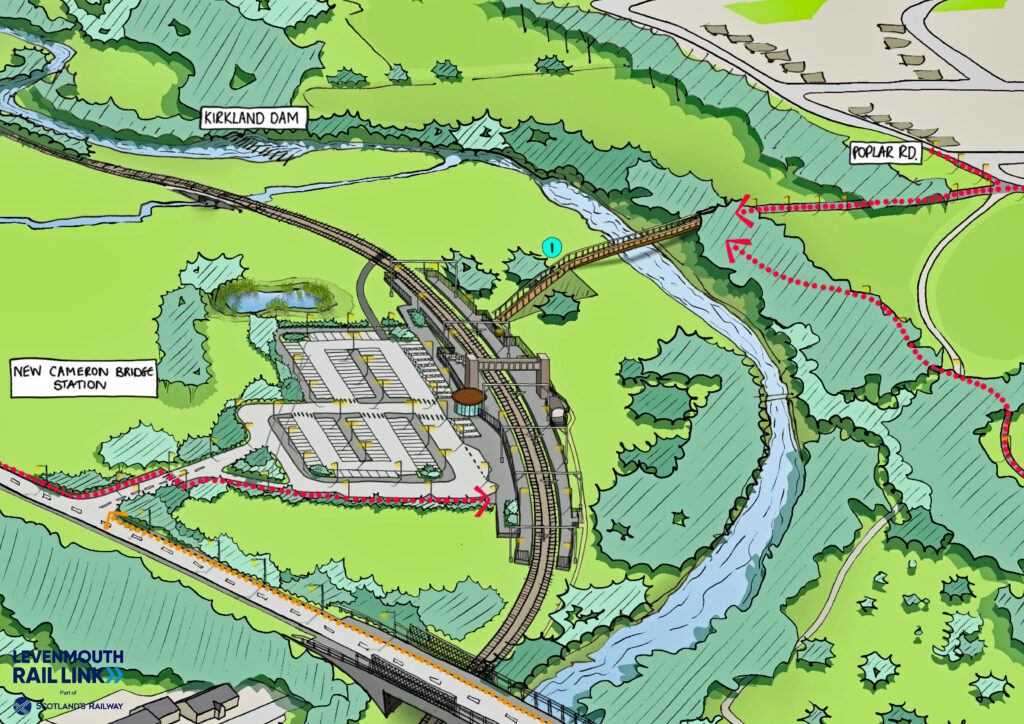
Work on the station started in January and will take about 10 months. Although planning permission, which was submitted in October, has yet to be received, permitted development rights and prior approval enables work to be done within the railway corridor.
Leven has a single 7-metre-wide, 210-metre-long island platform accessed by a ramp beyond the buffer stops. Its car park will have 134 spaces, including 12 for electric cars. The waiting shelter incorporates space for 16 cycles and train crew welfare facilities. To create a quality public realm, the area around the station is the subject of a placemaking study which is considering a central boulevard and waterfront path from station to town.
Beyond Leven, the old line continued over the River Leven to Methil docks which was once the largest coal exporting port in Scotland. There are currently no plans to extend the line beyond Leven.
Earthworks
The original line opened in 1854 as a single-track railway and was doubled in 1909. After it lost its passenger services it was singled in 1972. Its solum and bridges were therefore built for a two-track railway. However, the current formation is not necessarily acceptable as all rail re-opening projects require earthworks constructed to current standards which, at some locations, requires the purchase of some parcels of land.
The branch has no major earthworks although it follows the Rivers Ore and Leven for almost all its length. At some locations the line is quite close to these rivers and has some steep slopes above it. The largest slope at Tullybreck (1980 to 2170) had to be regraded to a 1 in 2 slope. Slope profiling was also required at Kirkland (6800 to 6950).
River works included a new retaining wall (3230 to 3380) and scour protection which required riverbanks to be established and voids filled before positioning 2,000 tonnes of locally sourced rock armour. This required precautions to be put in place to limit silt, such as in-river bubble curtains which form a barrier to block its spread. The largest scour work at Leven (8940 to 9110) required the river to be dammed around it. Note: figures in brackets are metres from Thornton Junction.
Track laying
In August, the first kilometre of track that had been laid in March was commissioned. In the same month, the switch at the start of the double track section, 1.2km from the junction, was installed. Track laying recommenced in October. During our visit on 5 December, track was being laid at Tullybrek, 1.8km from the junction. Three kilometres of ballast had also been laid and was being levelled in advance of track laying. Drainage work was also completed in advance of track laying.
Whilst on site, part-driven OLE piles could be seen. The piling work started in October using a track-mounted vibrating piling rig. Those piles that cannot be fully driven in this way are later hammer driven.
In May 2021, Thornton Yard took delivery of the 16,000 sleepers needed for the project and became a virtual quarry for the 80,000 tonnes of ballast needed by the project. Every two months or so a train delivers 32 x 216-metre lengths continuous welded rail (CWR) which is dragged ahead of the track laying. At the time of our visit, sufficient CWR to lay 1.6km of double track had been dragged ahead of the rail head.
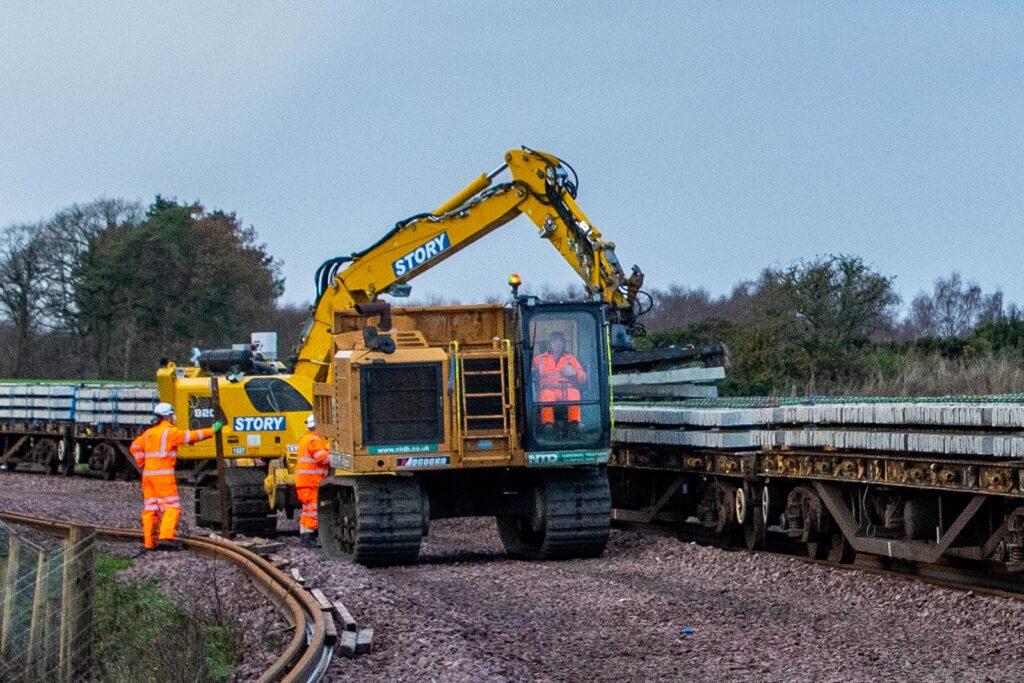
At 06:35 every weekday, an engineering train laden with sleepers is scheduled to enter the branch to travel to the rail head on the Down line which is 220 metres ahead of the Up line rail head. Once plant and manpower are on site, track laying is planned to start at 08:00. This is first done by an excavator fitted with a spider that can carry seven sleepers positioning sleepers on the Down line in front of the train. These are lifted from a large dumper truck which is occasionally loaded with sleepers by another spider-fitted excavator. To do so, the truck travels on formation of the unlaid Up line between the relaying site and the train.
At about 12:00, after four hours, 220 metres of sleepers have been laid on the Down line. Once these have been laid, the excavator that has laid the sleepers is fitted with a thimble position to place 2 x 214-metre lengths of CWR onto the sleepers. These are then clipped using a Rosenqvist CD400SP self-propelled clipping machine that can clip 30 sleepers per minute. This job is planned to be completed by 13:45. It takes about one hour and 15 minutes to place and clip the rails.
Whilst this is being done, the spider-fitted excavator that was loading the dumper track positions sleepers on the Up line. As this excavator is working adjacent to the train, the dumper truck is not now required. As a result, laying 220 metres of sleepers on the Up line is done in half the time it took to lay the Down line. Hence, Up line sleeper positioning is planned to be completed by 14:00 after which the train can be moved clear.
After re-positioning equipment as required, all plant and men are planned to be off site by 16:30. In this way a kilometre of double track is being laid each week. To accommodate other work, the track is being laid in five phases of which the current phase is the second. It is anticipated that the track laying will be completed by mid-August with the remaining project work completed by early December. After a few months of driver training, the line will re-open in Spring 2024.
Other work
During our visit, the original Cameron Bridge station platforms by the distillery were being removed to clear the way for the new double track railway. The rubble from these 210-metre-long old platforms totalled approximately 5,000 tonnes. This is to be used as infill for the new Cameron Bridge station platforms which are being built 200 metres to the east.
Utility work was also underway at the 75-year-old Bawbee Road bridge which crosses both the Leven station site and the river Leven and is used by 18,000 vehicles each day. This bridge is subject to an 18-tonne weight restriction due to chlorine contamination and corrosion. This requires the bridge to be closed whilst its deck and abutments are replaced at a cost of £8 million.
Due to the interface between this work and the rail project, it was agreed that the bridge renewal is best done by rail project on behalf of Fife Council. The bridge is soon to be closed with traffic diverted over a temporary road which includes a bridge over the river Leven. As yet, there is no completion date for this bridge work which need not be completed before the railway opens.
Revitalising Levenmouth
The Leven programme brings together public bodies, businesses, and community organisations to develop projects to improve the area. One such project is the River Leven Park which aims to create gardens on abandoned land along the river between Cameron Bridge and Leven. Another is a river restoration project.
The programme’s flagship project is the Levenmouth Connectivity Project. This is funded by Sustrans Scotland and Transport Scotland and aims to provide walking and cycling paths to connect communities along the river. This project is working closely with Network Rail to ensure that this active travel network is linked to the two new rail stations. This will require some existing paths across the railway to be replaced with a footbridge or underpass. Its initial priority is to ensure these links are delivered in time for the station opening in 2024.
The project team is also working closely with this programme both to help it maximise the opportunities provided by the new rail line and to explore cost-effective opportunities for using its plant and manpower.
Unfortunately, in the thinly-populated area at the start of the branch, paths across the line at Doubledikes and Tullybreck will have to close. For understandable reasons, Network Rail is unwilling to create level crossings. Neither of these paths is a right of way or an adopted Fife Core path and the cost of footbridges is not felt to be justifiable.
The milestone 100th meeting of the Levenmouth Rail Campaign was addressed by Alex Hynes, managing director of Scotland’s Railway. He noted that when the project team recently gave a presentation to the whole of Network Rail Scotland about this project they didn’t talk about rail, sleepers, or ballast. Instead, they talked about how this project will improve the life chances of people in Levenmouth by creating economic growth, improving health and wellbeing as well as social cohesion.
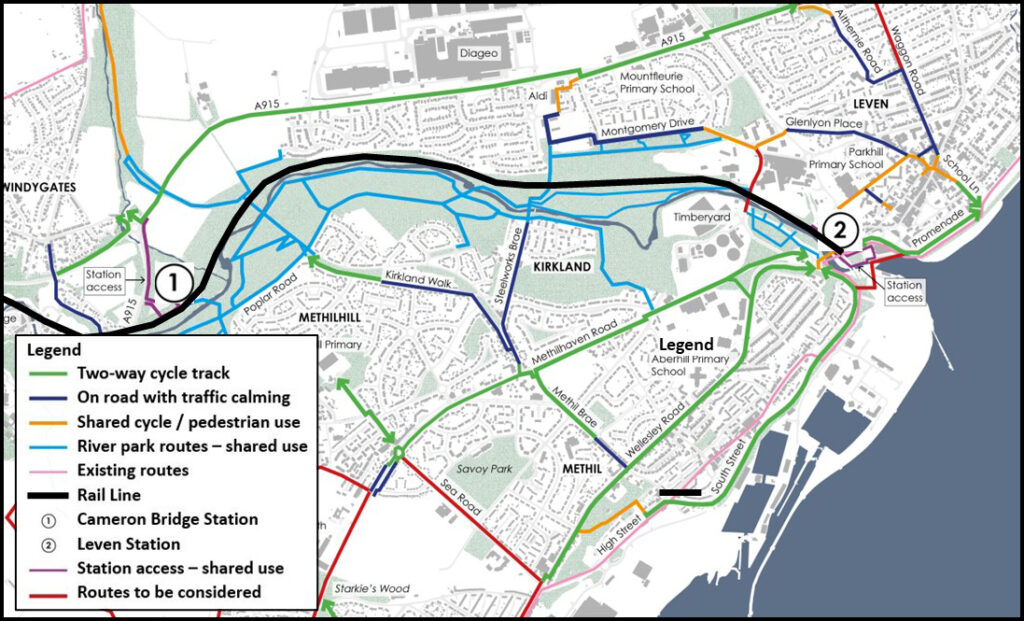
He noted that Network Rail hasn’t been given over £100 million of Scottish taxpayers’ money for this project because they like railways. It’s because they like what railways do. Alex also felt that “the Levenmouth Rail Campaign has done an amazing job and that they should feel exceptionally proud that we’re at this point.”
The railway will open during the campaign group’s 10th anniversary year. It takes time to justify and approve the large cost to re-open a railway and then to design and then build line.
There is certainly a buzz about this project which is quietly delivering a project which will certainly achieve the project team’s aim of making “Levenmouth a better place to live, work and play.” Rail Engineer thanks Network Rail’s Kirsty Ryder, Owen Campbell, and Joe Mulvenna for their help with this feature and helping us see the work that will achieve this transformation.
The project is one of a small number of Network Rail projects being delivered in accordance with the Project 13 delivery model. For the Levenmouth project, the enterprise partners are Transport Scotland as investor, Network Rail as owner, and AmcoGriffen, Atkins, Babcock, BAM, Siemens, SPL, Story, QTS, Rail Safety Accreditation Scheme (RSAS) as suppliers. Atkins is the designer and BAM is the principal contractor.
Three ways to lay track
In Scotland, the re-opening of the Levenmouth branch in 2024 follows the re-opening of the Borders railway in 2015 and that of the Airdrie to Bathgate line in 2010. The amount of track needed for the Levenmouth, Borders, and Airdrie to Bathgate projects is respectively 19, 65, and 46 single track kilometres.
Levenmouth – rails first
Before track laying on the Levenmouth branch can commence, 216-metre lengths of continuous welded rail (CWR) have to be left in position well in advance of the track laying. This requires sleepers to be lifted off an engineering train, positioned on the track bed using two excavators and a dumper truck. An excavator then thimbles the rails into position for them to be clipped up with a clipping machine. In this way, 220 metres of double track is laid in 8.5 hours, which is 52 metres per hour.

Airdrie to Bathgate (A2B) – rails first
Rails also had to be laid in advance for the A2B project which laid track using Balfour Beatty’s high output new track construction machine which carries sufficient steel sleepers for 1.2kms of track, less if concrete sleepers are used. This machine was also used for the recent Okehampton re-opening. As it moves it lays sleepers in position at the rate of 12 per minute, feeds the CWR in place and clips it into position. The A2B project laid track in 6km stages, which was found to be the maximum practical distance that CWR could be dragged along the new formation. The track construction machine lays track at 185 metres per hour.
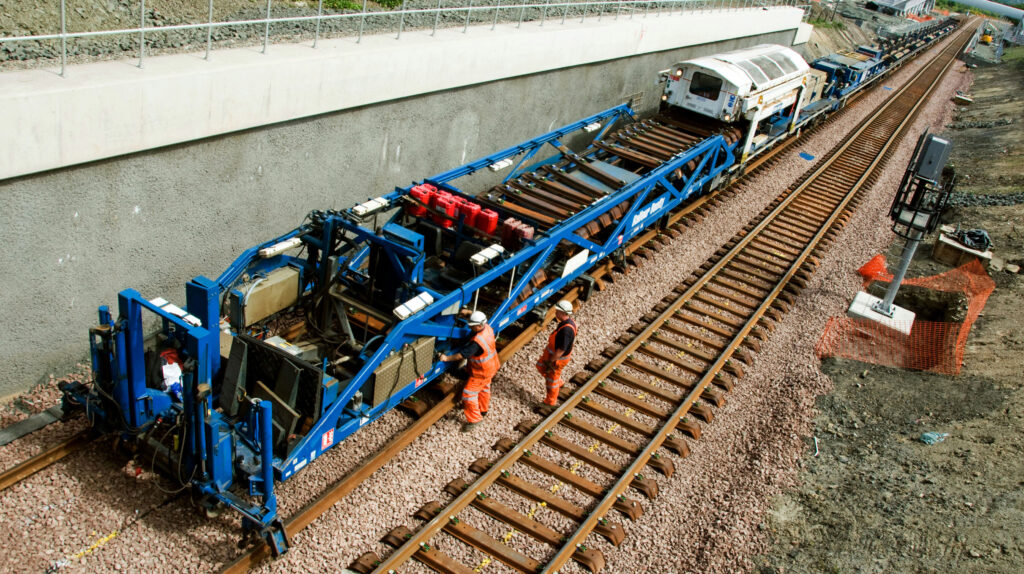
Borders – sleepers first
Borders tracklaying used a technique developed by BAM Rail of Holland which was used on the construction of the Dutch high-speed line which needs sleepers to be in place beforehand. These were deposited on the track bed off lorries in piles of 20 and were then put in place by a spider-fitted excavator. The BAM process has four self-propelled units which pull the CWR off its delivery train to place it on the sleepers. The four units are a main roller unit connected to the CWR train by a three-metre bar; a power unit, an auxiliary roller and winch unit; and a mobile rail positioning unit on caterpillar tracks. After the rails are in position, they are clipped up by Robel clipping machines.
The BAM process was observed to lay track at 185 metres per hour.
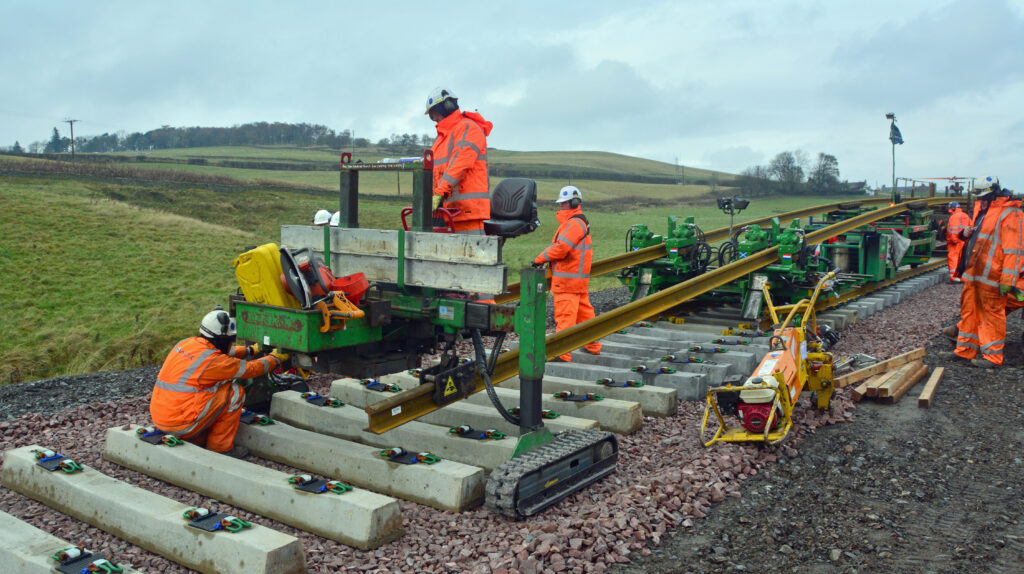
Which is best?
Both the Balfour Beatty and BAM ways of laying track do so at the same rate of 185 metres per hour. The Borders project team, many of whom delivered the A2B project, felt that, for a new railway, there was little to distinguish between. Whilst these two automatic processes lay track at three times the rate of the Levenmouth track laying, this does not necessarily make them better. Levenmouth has much less track to lay than the other two projects so it may be difficult to justify this expensive plant, including its set up and transport to site.
Another issue is the importance of track laying speed to the project programme. Whilst track laying might be on the critical path for a new railway with a long length of track to lay, this is not the case for the Levenmouth project. Another issue is that using high output tracklaying plant locks the programme into its availability. Using conventional plant to lay track, as at Levenmouth, offers greater flexibility.
So, whilst it is interesting to compare these different techniques, there can be no definitive answer to the question of which is best as it depends on the circumstances.

